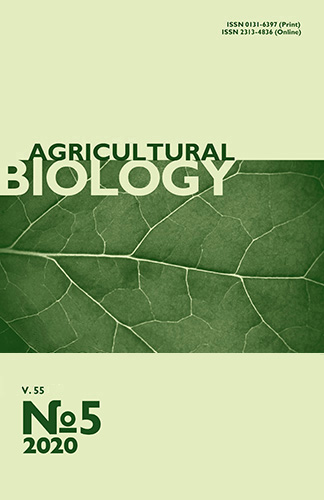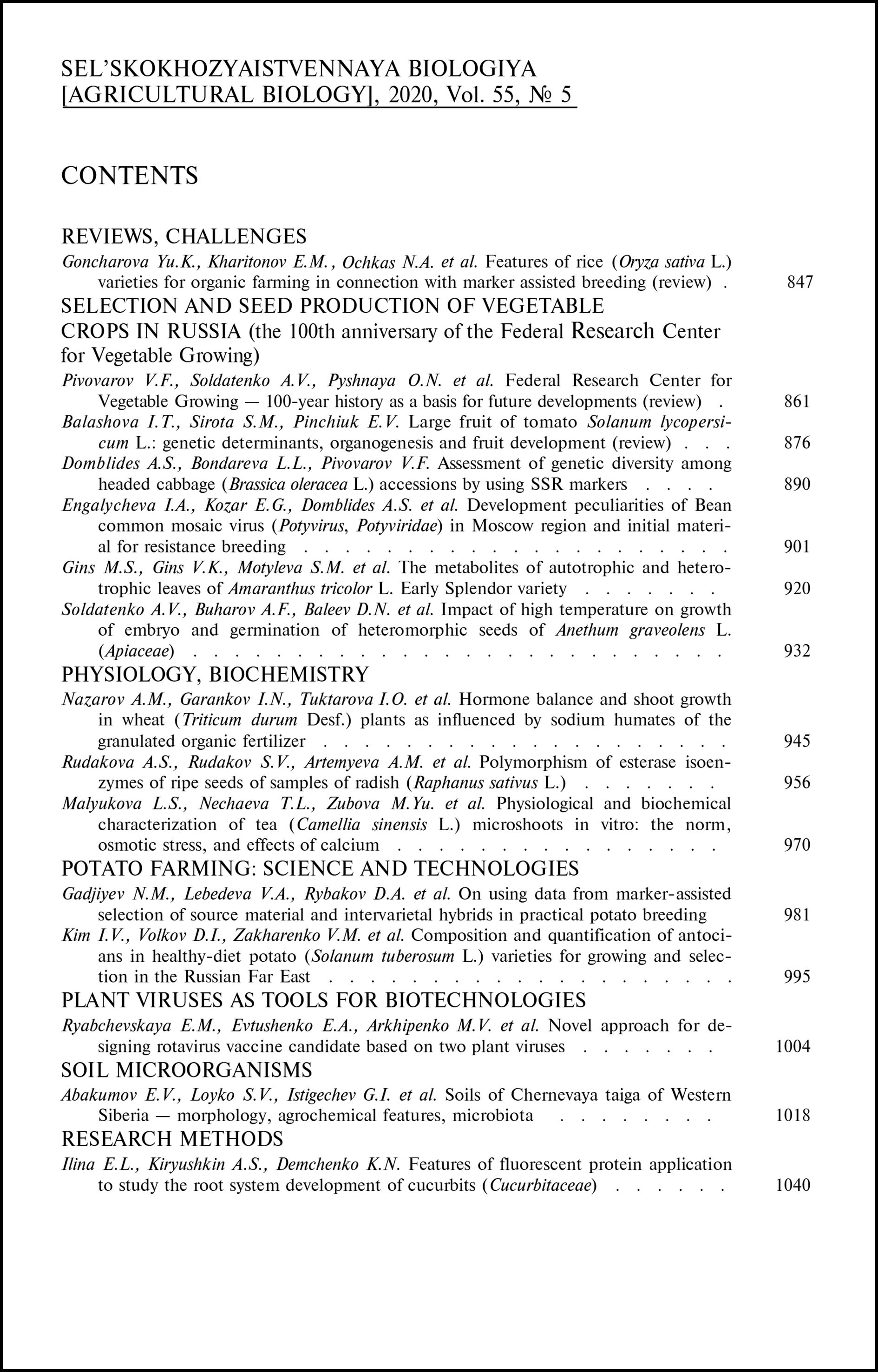doi: 10.15389/agrobiology.2020.5.995eng
UDC: 633.491:547.973(571.6)
Acknowledgements:
Supported financially by the Federal Research Program for 2017-2025, Sub-Program “Potato breeding and seed production”
COMPOSITION AND QUANTIFICATION OF ANTOCIANS IN HEALTHY-DIET POTATO (Solanum tuberosum L.) VARIETIES FOR GROWING AND SELECTION IN THE RUSSIAN FAR EAST
I.V. Kim1 ✉, D.I. Volkov1, V.M. Zakharenko2, A.M. Zakharenko2,
K.S. Golohvast2, A.G. Klykov1
1Chaika Federal Research Center of Agricultural Biotechnology of the Far East, 30, ul. Volozhenina, pos. Timityazevskii, Ussuryisk, Primorskii Krai, 692539 Russia, e-mail kimira-80@mail.ru (✉ corresponding author), volkov_dima@inbox.ru, alex.klykov@mail.ru;
2Far Eastern Federal University, 8, ul. Sukhanova, Vladivostok, 690091 Russia, e-mail rarf@ya.ru, rarf247@gmail.com, golokhvast.ks@dvfu.ru
ORCID:
Kim I.V. orcid.org/0000-0002-0656-0645
Zakharenko A.M. orcid.org/0000-0002-9520-8271
Volkov D.I. orcid.org/0000-0002-9364-9225
Golohvast K.S. orcid.org/0000-0002-4873-2281
Zakharenko V.M. orcid.org/0000-0001-5809-6250
Klykov A.G. orcid.org/0000-0002-2390-3486
Received February 4, 2020
The potato (Solanum tuberosum L.) has been the focus of dietary research in recent decades due to its ability to accumulate phenolic substances (anthocyanins) in tubers. In Russia, such varieties have been created for a number of regions, but in the Far East, the program to increase the content of anthocyanins in potato tubers has recently begun. In the presented study using liquid chromatography and second-order mass spectrometry methods, we profiled anthocyanins and quantified their accumulation for potato varieties of different origin (Russia, Ukraine, Belarus, Kazakhstan, Germany, the Netherlands), which had not previously been characterized by this feature. For the first time, four dietary Russian varieties with an increased content of anthocyanins have been identified. This work aimed to determine the profiles of anthocyanins and their content in tubers in the conditions of the Russian Far East. We used 22 varieties selected for early maturity, productivity, low starch content and different color of tubers and flowers. The anthocyanin profile was double-identified, by the retention time on a C18 reverse phase column with detection of absorbance at wavelength range 400-700 nm and ESI-MS/MS in positive ionization mode. Anthocyanins were quantified spectrophotometrically. The anthocyanins identified in the tubers were delphinidin, petunidin, malvidin, cyanidin, and pelargonidin. Delphinidin and cyanidin were found in mono- and diglycosylated forms. It was revealed that petunidin-3-glucoside is the most common anthocyanin which is present in almost all of the studied varieties. In tubers, depending on varietal specificity, there were from 1 to 5 anthocyanins of those found. Varieties with yellow skin and pink spots on the yellow tuber skin were characterized by a low content of anthocyanins. The pink and dark pink color of the skin positively correlates with the content of pelargonidin-3-glucoside, while petunidin-3-glucoside and cyanidin-3-glucoside give a purple and blue-violet color to the skin of the tuber. The anthocyanin level was the highest in Phioletovii variety (310 mg/kg cyanidin-3-glucoside, 50 mg/kg malvidin, 30 mg/kg delphinidin), Vasilyok variety (150 mg/kg petunidin), and in Mayak (95 mg/kg pelargonidin) and Kuznechanka (78 mg/kg pelargonidin) varieties. In the Phioletovii variety, the cyanidin-3-glucoside prevailed. We recommend to involve varieties with pink, dark pink, purple and blue-purple tuber skin in selection for an increased content of anthocyanins.
Keywords: Solanum tuberosum L.,potatoes, dietary varieties, anthocyanins, delphinidin, petunidin, malvidin, cyanidin, pelargonidin, mass spectrometry, HPLC.
REFERENCES
- Zhevora S.V., Anisimov B.V., Simakov E.A., Oves E.V., Zebrin S.N. Kartofel' i ovoshchi, 2019, 7: 2-7 (in Russ.).
- Ivanisenko T.V., Saik O.V., Demenkov P.S., Khlestkin V.K., Khlestkina E.K., Kolchanov N.A., Ivanisenko V.A. Vavilovskii zhurnal genetiki i selektsii, 2018, 22(1): 8-17 CrossRef (in Russ.).
- Zhang Y., Cheng S., De Jong D., Griffiths H., Halitschke R., De Jong W. The potato R locus codes for dihydroflavonol 4-reductase. Theor. Appl. Genet., 2009, 119(5): 931-937 CrossRef
- Wegener C.B., Jansen G. Soft-rot resistance of coloured potato cultivars (Solanum tuberosum L.): the role of anthocyanins. Potato Res., 2007, 50(1): 31-44 CrossRef
- Simakov E.A., Anisimov B.V., Mityushkin A.V., Zhevora S.V., Starovoitov V.I., Oves E.V., Zhuravlev A.A., Meleshin A.A., Zebrin S.N., Zeiruk V.N., Uskov A.I., Zharova V.A., Mityushkin Al.R.V., Shabanov A.E., Mal'tsev S.V., Salyukov S.S., Ovechkin S.V., Semenov V.A., Gaizatulin A.S. Sorta kartofelya selektsionnogo tsentra VNIIKKH. Potrebitel'skie i stolovye kachestva, kulinarnyi tip [Potato varieties of the VNIIKH breeding center. Consumer and dining qualities, culinary type]. Moscow, 2016 (in Russ.).
- Mulinacci N., Ieri F., Giaccherini C., Innocenti M., Andrenelli L., Canova G., Saracchi M., Casiraghi M.C. Effect of cooking on the anthocyanins, phenolic acids, glycoalkaloids, and resistant starch content in two pigmented cultivars of Solanum tuberosum L. J. Agric. Food Chem., 2008, 56(24): 11830-11837 CrossRef
- Cassidy A., O'Reilly Ѐ.J., Kay C., Sampson L., Franz M., Forman J.P., Curhan G., Rimm E.B. Habitual intake of flavonoid subclasses and incident hypertension in adults. The American Journal of Clinical Nutrition,2011, 93(2): 338-347 CrossRef
- Hui C., Bi Y., Xiaopin Y., Lon Y., Chunye C., Mantian M., Wenhua L. Anticancer activities of an anthocyanin-rich extract from black rice against breast cancer cells in vitro and in vivo. Nutrition and Cancer, 2010, 62(8): 1128-1136 CrossRef
- Sancho R.A.S., Pastore G.M. Evaluation of the effects of anthocyanins in type 2 diabetes. Food Research International, 2012, 46(1): 378-386 CrossRef
- Strygina K.V., Khlestkina E.K. Anthocyanins synthesis in potato (Solanum tuberosum L.): genetic markers for smart breeding (review). Sel'skokhozyaistvennaya biologiya [Agricultural Biology], 2017, 52(1): 37-49 CrossRef
- Zhang Y., Jung C.S., De Jong W.S. Genetic analysis of pigmented tuber flesh in potato. Theor. Appl. Genet., 2009, 119(1): 143-150 CrossRef
- Stushnoff C., Ducreux L.J., Hancock R.D., Hedley P.E., Holm D.G., McDougall G.J., McNicol J.W., Morris W. L., Sugurtas J.A., Verrall S.R., Zuber T., Taylor M.A. Flavonoid profiling and transcriptome analysis reveals new gene-metabolite correlations in tubers of Solanum tuberosum L. Journal of Experimental Botany, 2010, 61(4): 1225-1238 CrossRef
- Feller A., Machemer K., Braun E.L., Grotewold E. Evolutionary and comparative analysis of MYB and bHLH plant transcription factors. Plant J., 2011, 66(1): 94-116 CrossRef
- Allan A.C., Hellens R.P., Laing W.A. MYB transcription factors that colour our fruit. Trends in Plant Science, 2008, 13(3): 99-102 CrossRef
- Dubos C., Stracke R., Groteworld E., Weisshar B., Martin C., Lepiniec L. MYB transcription factors in Arabidopsis. Trends in Plant Science, 2010, 15(10): 573-581 CrossRef
- Andre C.M., Ourfir M., Guignard C., Hoffman L., Hausman J.F., Evers D., Larondelle Y. Antioxidant profiling of native Andean potato tubers (Solanum tuberosum L.)reveals cultivars with high levels of beta-carotene, alpha-tocopherol, chlorogenic acid, and petanin. J. Agric. Food Chem., 2007, 55(26): 10839-10849 CrossRef
- Deineka L.A. Nauchnye vedomosti BelGU. Seriya: Meditsina i farmatsiya, 2006, 3(4): 92-100 (in Russ.).
- Andersen Ø.M., Jordheim M. The anthocyanins. In: Flavonoids: chemistry, biochemistry and applications. Ø.M. Andersen, K.R. Markham (eds.). London, CRC Press. 2006: 471-552.
- Eichhorn S., Winterhalter P. Anthocyanins from pigmented potato (Solanum tuberosum L.) varieties. Food Research International, 2005, 38(8-9): 943-948 CrossRef
- Lewis C.E., Walker J.R.L., Lancaster J.E., Sutton K.H. Determination of anthocyanins, flavonoids and phenolic acids in coloured potatoes. I: Coloured cultivars of Solanum tuberosum L. J. Sci. Food Agric., 1998, 77(1): 45-57 CrossRef
- Meleshina O.V., Meleshin A.A. Materialy Mezhdunarodnoi nauchno-prakticheskoi konferentsii «Sovremennoe sostoyanie i perspektivy razvitiya selektsii i semenovodstva kartofelya» [Proc. Int. Conf. «Current state and prospects for the development of potato breeding and seed production»]. Moscow, 2018: 129-139 (in Russ.).
- Kim I.V., Klykov A.G. Vestnik DVO RAN, 2018, 3: 12-15 (in Russ">CrossRef
- Mityushkin A.A., Zhuravlev A.A., Zharova V.A., Mityushkin A.V., Salyukov S.S., Ovechkin S.V., Gaizatulin A.S., Simakov E.A. Kartofelevodstvo (sb. nauch. tr.) [Potato growing]. Minsk, 2018, Iss. 26: 57-64 (in Russ.).
- Anisimov B.V., Elanskii S.N., Zeiruk V.N., Kuznetsova M.A., Simakov E.A., Sklyarova N.P., Filipov S.N., YAshina I.M. Sorta kartofelya, vozdelyvaemye v Rossii [Potato varieties cultivated in Russia]. Moscow, 2013 (in Russ.).
- Dodds K.S., Long D.H. The inheritance of color in diploid potatoes. 1. Types of anthocyanins and their genetic loci. Journ. of Genetics, 1955, 53: 136-149 CrossRef
- Wang H., Race E.J., Shrikhande A.J. Characterization of anthocyanins in grape juices by ion trap liquid chromatography—mass spectrometry. J. Agric. Food Chem., 2003, 51(7): 1839-1844 CrossRef
- Kalita D., Jayanty S.S. Comparison of polyphenol content and antioxidant capacity of colored potato tubers, pomegranate and blueberries. Journal of Food Processing and Technology, 2014, 5: 358 CrossRef












